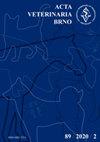Concentration of vitamin E in bovine plasma and erythrocytes
IF 0.7
4区 农林科学
Q3 VETERINARY SCIENCES
引用次数: 0
Abstract
The aim of this study was to determine and compare the plasma and erythrocyte (RBCs) levels of vitamin E in cows of 3 different categories (2–3 weeks antepartum, 1–3 weeks and 2.5–3 months of lactation) and 1-month-old calves on dairy nutrition. We were interested in the degree of correlation of vitamin E in plasma and RBCs within the individual categories. Blood on EDTA was collected from 61 cows and 12 calves. As a part of the haematological examination, we determined haematocrit (HCT) immediately after the collection. We determined vitamin E from plasma and RBCs by a standard HPLC method. We compared the results of vitamin E in plasma and RBCs and correlated them. The concentration of vitamin E in the plasma and RBCs was 6.98 and 3.45 μmol/l, respectively, in cows 2–3 weeks antepartum; 1–3 weeks of lactation it was 4.98 and 3.34; 2.5–3 months of lactation 11.76 and 2.80 μmol/l; and in the case of calves 12.07 and 6.29 μmol/l. Weak correlations were observed between vitamin E in plasma and the RBC concentrations in the antepartum category R2 = 0.2076; 1–3 weeks of lactation R2 = 0.0369; 2.5–3 months of lactation R2 = 0.2403 and calves on dairy nutrition R2 = 0.4628. Vitamin E concentrations in RBCs were shown to be more stable than in plasma, where the concentrations varied. It is possible that vitamin E in RBCs could tell us more about the longer-term reserves of vitamin E in the organism. The highest concentration of vitamin E in plasma and RBCs, as well as a stronger correlation was found in calves.牛血浆和红细胞中维生素E的浓度
本研究旨在测定和比较3种不同类型奶牛(产前2-3周、泌乳1-3周和泌乳2.5-3个月)和1月龄犊牛的血浆和红细胞(rbc)维生素E水平。我们对血浆中维生素E和红细胞在个体类别中的相关性程度很感兴趣。从61头奶牛和12头小牛身上采集了EDTA血液。作为血液学检查的一部分,我们在采集后立即测定红细胞压积(HCT)。我们用标准的高效液相色谱法测定血浆和红细胞中的维生素E。我们比较了血浆和红细胞中维生素E的结果,并将它们联系起来。产前2 ~ 3周奶牛血浆和红细胞中维生素E浓度分别为6.98和3.45 μmol/l;哺乳期1 ~ 3周分别为4.98和3.34;哺乳期2.5 ~ 3个月分别为11.76和2.80 μmol/l;犊牛则分别为12.07和6.29 μmol/l。产前血浆维生素E与红细胞浓度呈弱相关(R2 = 0.2076);哺乳期1-3周R2 = 0.0369;哺乳2.5 ~ 3个月的R2 = 0.2403,犊牛乳营养R2 = 0.4628。红细胞中的维生素E浓度比血浆中的维生素E浓度更稳定,而血浆中的维生素E浓度会发生变化。红细胞中的维生素E可能会告诉我们更多关于机体中维生素E的长期储备。在犊牛中发现血浆和红细胞中维生素E浓度最高,且相关性更强。
本文章由计算机程序翻译,如有差异,请以英文原文为准。
求助全文
约1分钟内获得全文
求助全文
来源期刊

Acta Veterinaria Brno
农林科学-兽医学
CiteScore
1.00
自引率
33.30%
发文量
36
审稿时长
18-36 weeks
期刊介绍:
ACTA VETERINARIA BRNO is a scientific journal of the University of Veterinary and Pharmaceutical Sciences in Brno, Czech Republic.
The scientific journal Acta Veterinaria Brno is dedicated to the publication of original research findings and clinical observations in veterinary and biomedical sciences. Original scientific research articles reporting new and substantial contribution to veterinary science and original methods that have not been submitted for publication elsewhere are considered for publication. A written statement to this effect should accompany the manuscript, along with approval for publication by the author´s head of department. The authors bear full responsibility for the contents of their contribution. Book reviews are published, too.
 求助内容:
求助内容: 应助结果提醒方式:
应助结果提醒方式:


